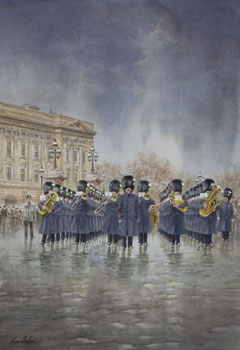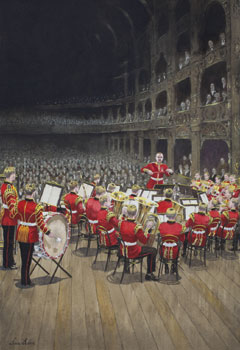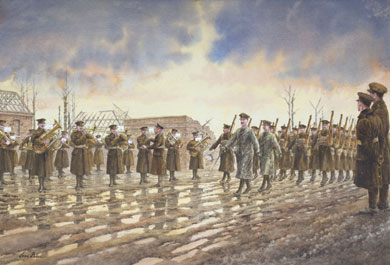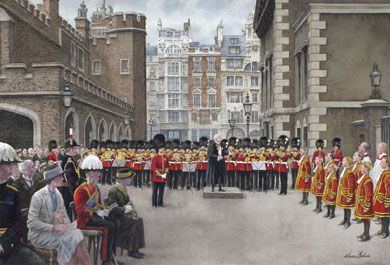|
THE BAND OF THE WELSH GUARDS - A HUNDRED YEARS ON
by Colin Dean
former Band Secretary,
Band of the Irish Guards
|
The Band of the Welsh Guards was formed in 1915 but reserved its centenary celebrations for the anniversary of its first public appearance, marking the event with a celebration concert, the launch of a book on the band’s history, and the issue on compact disc of recordings by its founder members. In addition, the band commissioned four paintings from the renowned artist Sean Bolan to illustrate its early history.
 The band’s first parade - Guard Mounting on 1st March 1916. The band is slow marching from Buckingham Palace at the head of the Old Guard and is led, not by a Drum Major, but by the Band Sergeant who can be seen holding a clarinet (From a painting by Sean Bolan)
The band’s first parade - Guard Mounting on 1st March 1916. The band is slow marching from Buckingham Palace at the head of the Old Guard and is led, not by a Drum Major, but by the Band Sergeant who can be seen holding a clarinet (From a painting by Sean Bolan) |
We are currently in the midst of commemorating the centenary of the events of the First World War. While the armistice brought a conclusion in our favour, the only real cause to ‘celebrate’ was a halt to the loss of lives. However, there was something else to emerge from that ghastly war which we can rightly celebrate: the formation of a Welsh Regiment of Foot Guards and its Regimental Band.
It might seem a little strange to think that the formation of a regimental band should even be considered in the midst of the First World War when the bands of regiments of the line had been stood down. However, the existing Foot Guards bands were making a significant contribution to the war effort through their music, helping to raise national morale and instil a sense of patriotism to encourage young men to answer the call to the Colours, and from October 1915 they were detailed in rotation to visit the Guards Division in France and Belgium.
The first evidence of plans to form a band can be found in a letter dated 27th April 1915 from the Lord Mayor of Cardiff, Alderman J T Richards, saying that the City ‘wished to have the honour and privilege of presenting a Band to the Regiment of Welsh Guards’. The money was raised through public subscription and on 22nd June 1915 the Lord Mayor presented a cheque for the sum of £527 to Lord Harlech, Lieutenant Colonel Commanding, for the purchase of its first instruments.
There were upwards of 150 bandmasters of cavalry regiments and infantry battalions at that time whose bands had ceased to function as such on the outbreak of war and who, in most cases, had returned to their regiments’ depots to train band boys. The Welsh Guards was to be only the eleventh of what might be termed the senior appointments and so the competition for the post of its bandmaster would have been tremendous.
On 6th September 1915 the King’s Private Secretary, Lord Stamfordham, wrote to Lord Harlech saying ‘The King approves of Mr Andrew Harris being appointed Bandmaster of the Welsh Guards, but His Majesty thinks it is a pity that this post has not been given to a Welshman’.
Despite that particular failing, Mr Harris transferred from the Royal Artillery Gibraltar Band and took up the appointment of Bandmaster on 1st October 1915. Henry Roxberry, having left the Grenadiers earlier in the year, was appointed as Band Sergeant in the following month. Together they assembled the musicians to form the band and were to lead it for over 21 years, creating a sense of continuity and stability which enabled it to develop and forge its own identity, whilst maintaining the traditions of the other Bands of the Brigade of Guards with histories dating as far back as 1685.
 The band’s first concert performance at the London Opera House conducted by Mr Andrew Harris. Note the decorative tunics worn by the percussionists, a relic of the days in the 18th Century when the Foot Guards Bands had flamboyantly dressed percussionists
The band’s first concert performance at the London Opera House conducted by Mr Andrew Harris. Note the decorative tunics worn by the percussionists, a relic of the days in the 18th Century when the Foot Guards Bands had flamboyantly dressed percussionists
(From a painting by Sean Bolan) |
Amongst the band’s founder members was Aubrey Brain, one of the country’s most distinguished French horn players and father of Dennis Brain, who went on to attain even greater fame as a horn player.
History relates that the band gave its first performances on 1st March 1916 but they had, in fact, already been into the studio to record the music for five 78rpm discs on the Regal label, beginning with the regimental music. Most of these records have recently been discovered and remastered, and can be heard on compact discs now available from the British Military Music Archive (bmma.org.uk).
The band undertook its first official duty at Guard Mounting on 1st March 1916, St David’s Day, exactly one year after the 1st Battalion had mounted its first King’s Guard. The ceremony took place in the forecourt of Buckingham Palace, something which was then still a comparatively recent custom which had started in 1903 on days when the Sovereign was in residence (St James’s Palace being the normal setting).
The Scots Guards took over the duties from the Grenadier Guards, all dressed in wartime khaki with forage caps, while the band was in greatcoats and bearskins. The band took up what was then the usual position near the Equerries’ Entrance on the north side of the forecourt towards Green Park and played a number of selections while the various sentries were posted. As would be expected, these were mostly Welsh and included Men of Harlech and God Bless the Prince of Wales as well as other national airs which were much appreciated by the crowd of spectators.
That evening the band made its first appearance on the concert platform at a Grand Welsh Patriotic Meeting held at the London Opera House in Kingsway (not to be confused with the Royal Opera House) wearing scarlet tunics for the first time. Welsh songs were sung by Ben Davies and Ivor Foster, and reports tell us that the newly-formed band admirably performed Welsh music at intervals. The concert was held in support of the National Fund for supplying comforts to the Welsh troops and was presided over by Lord Harlech.
As a means of showing appreciation for the instruments, Mr Harris wrote to Cardiff Corporation telling them that he was keeping the Whitsun weekend open for them to make a visit but, in the event, this was advanced to Easter (24th-26th April 1916) and the band began the season of concerts at Roath Park in Cardiff.
The programmes included the overture to Ruy Blas (Mendelssohn), selections from the ballet Sylvia (Delibes) and from the opera Aida (Verdi), Welsh Rhapsody (German) and the slow movement from Schubert’s Unfinished Symphony, as well as some shorter items.
Despite unfavourable weather, the audiences numbered around 5,000 people at any one time and it was estimated that about 15,000 people visited the park in the course of each day, causing the tramcars to be packed on every trip. It is very evident from the reports in the press the next day that the programmes were thoroughly enjoyed by the large audience and that ‘The Welsh Guards Band has already won a reputation for its brilliant playing’ (South Wales Daily News).
The Band of the Welsh Guards first took its turn to visit the Guards Division from 28th October 1916 to 11th February 1917. Not long after they arrived, 1st Battalion Welsh Guards were completing a very wet and disagreeable tour in the front line near Geudecourt in Northern France, suffering forty-three casualties, but were finally relieved by 1st Battalion Scots Guards and the 60th Australian Infantry Brigade. They had a few hours’ rest at H Camp before marching towards their billets at a rather dreary ruin of a village at Meault. This was where the battalion was to encounter its regimental band for the first time as Mr Harris had positioned his musicians a couple of miles outside the village in order that their music might help lift the men’s spirits as they played them back to their billets.
 The historic moment at Meault as the band and battalion met for the first time (From a painting by Sean Bolan)
The historic moment at Meault as the band and battalion met for the first time (From a painting by Sean Bolan) |
Mr Harris’s intentions were clearly much appreciated although, in effect, the band only led in The Prince of Wales Company marching in file, as the orders were that there should be an interval of 200 yards between companies. However, they played for each company in turn as it marched into the village, quite a dramatic moment as these tired and exhausted men heard their own band and their regimental march, The Rising of the Lark, for the first time.
During the winter months that followed, the band often played in the open during the afternoons at forward areas such as Meault, and in large army huts or the town hall in Arras. Against these conditions the band worked ‘with heroic vim and cheerfulness; their fingers may have been frozen - their faces were certainly blue - but they played lively tunes without rest’. They also played for the battalion’s Christmas dinner when the men each had a quarter of a pound of plum pudding, a quart of beer and two packets of cigarettes.
Mr Harris was later to recall: ‘I took the band out to France and we had some remarkable experiences there. Standing on duck-boards in a second-line trench at the Battle of the Somme, we provided music to cheer the Irish Guards. Before we had finished the first part of our programme we were up to our knees in mud and water. The trench boards had sunk’.
For a week during May 1917 there was a further illustration of the power of music, this time in its use as war propaganda with a visit to Paris by the five Bands of the Brigade of Guards at the request of the French government and approved by King George V. The bands made a splendid spectacle in scarlet tunics and bearskin caps as they walked onto the stage for a concert at the Trocadero, with the Garde Republicaine Band seated on the floor of the hall playing Salut a la Garde Britannique, especially composed for the occasion by their conductor, Captain Balay.
In February 1918 the five bands made a similar visit to Italy, travelling by train from Boulogne to Rome. While they were there the Queen (of Italy) presented all members of the massed bands with a silver cigarette case and the Roman Catholics in the massed bands were received by the Pope at the Vatican. They then went on to play in Florence and Milan where they gave a concert at the Scala Theatre. On the return journey the Band of the Welsh Guards stopped at Paris to give some concerts to the wounded and men on leave, and then went to Arras to begin its second tour of duty with the Guards Division.
The band, under the newly commissioned Lieutenant Andrew Harris, was present at Barnes railway station on 12th March 1919 to play Handel’s See the Conquering Hero Comes as the train pulled in as 1st Battalion Welsh Guards finally returned to England, then some lively Welsh airs as it led them to the Ranelagh Club where they were to be stationed.
In May 1919 it joined with the Coldstream Guards to lead the gun carriage bearing the remains of Nurse Edith Cavell - and the following year it was part of the massed bands which led the coffin of the Unknown Warrior through London, stopping at the Cenotaph while it was unveiled by the King, and then continuing to Westminster Abbey.
It took part in the King’s Birthday Parade for the first time on 3rd June 1919 when the King’s Colour of 3rd Battalion Coldstream Guards was trooped. The parade was held in Hyde Park because huts had been erected on Horse Guards Parade - and it was a unique occasion in that there were eleven Guards on parade, found by each of the battalions from the then six regiments of Foot Guards, including the Guards Machine Gun Regiment. The massed bands and drums were led by nine Drum Majors in state clothing, and the three mounted bands of the Household Cavalry were on parade.
The band returned to Paris to lead the British contingent in the Victory March on 14th July 1919 and it was back for the Victory March through London 5 days later.
Amongst the numerous highlights of the inter-war years, the band was at the newly constructed Wembley Stadium in 1924 for the Empire Exhibition, taking part in a Welsh Concert, along with the Welsh Symphony Orchestra and thirty Welsh Choirs, all under the baton of Sir Walford Davies. It was back at Wembley the following year for the Torchlight Tattoo which included the Massed Bands of the Brigade of Guards.
One of the most memorable events in the band’s history took place on 8th June 1932 when King George V unveiled the memorial to his mother, Queen Alexandra, in the garden wall of Marlborough House opposite Friary Court at St James’s Palace.
The band was positioned on the north side of Marlborough Road by the Queen’s Chapel, in tunics and bearskins, standing in concert formation and playing from music stands with a small rostrum for the conductor. Between the band and the memorial stood the Choirs of the Chapels Royal and Westminster Abbey - including a young chorister who was to become the great choral conductor Sir David Willcocks.
To begin the Dedication Service, the Poet Laureate had written ‘Queen Alexandra’s Memorial Ode’ which was set to music by Sir Edward Elgar, the Master of the King’s Musick, and arranged for the band by Captain Harris. The band thus had the unique honour of giving the first performance of a work by Sir Edward Elgar which he himself conducted.
 Sir Edward Elgar conducting the Band of the Welsh Guards in 1932
Sir Edward Elgar conducting the Band of the Welsh Guards in 1932
(From a painting by Sean Bolan) |
Major Harris’s last parade was for Guard Mounting at St James’s Palace on 12th December 1937 and his final public engagement was a service that afternoon at St Martin-in-the-Fields. He had led the band for more than 22 years, making him very much the ‘father of the band’.
1938 dawned with a new Director of Music, Lieutenant Tommy Chandler, who took over with the expectation of ten years of colourful pageantry to look forward to but, in the event, the majority of his tenure was to be spent in wartime khaki as he led the band very successfully through the difficult years of the Second World War.
However, to begin with, life carried on very much as before with the band’s summer season including regular engagements playing in the London Parks and at the seaside bandstands. The band was booked to appear at the New Zealand Centennial Exhibition in 1939 for an engagement which was to last about six months meaning that, with the long voyages, the band would have been away from London for nearly nine months.
They were practically on the point of sailing when war intervened. The outbreak of war soon led to a change in the order of dress: ‘Dress for bands when Guard Mounting will be service dress. Service dress caps will be worn and steel helmets carried over the right shoulder. Gasmasks will be slung over the right shoulder and will hang level with the bottom of the service dress jacket’.
The musicians soon found themselves giving numerous concerts each week to the large number of Guardsmen who were filling the vast number of training centres, as well as making regular visits to the battalions. In September 1940 the band made its first appearance on what was to become a long-running BBC series of ‘Music While You Work’, a programme of non-stop lively music which was primarily designed for the benefit of workers in the factories producing munitions to aid the war effort.
The King had authorised the formation of Second Battalions for the Irish and Welsh Guards in April 1939 and this gave the opportunity for the establishment of their regiments’ bands to be increased to the same strength as the other bands in the brigade: 1 Director of Music, 3 sergeants, 3 corporals and 60 musicians. As the numbers increased there were shades of Private Pike with an order issued to the newly joined musicians from Band Sergeant Percy Tilbrook that: ‘No woollen scarves are allowed to be worn around the neck under a greatcoat’.
As a result of the increased establishment, coupled with the effects of conscription, the band had the opportunity to recruit many professional musicians to its ranks, including three members of the Geraldo Orchestra, saxophonists George Evans and Harry Hayes - and Jimmy Coombes, a very fine trombone soloist who was regularly featured in band programmes.
Having such talented musicians was a great boost for the Welsh Guards and particularly their Dance Orchestra which was of a sufficiently high standard for them to broadcast on ‘Music While You Work’ in 1943 and to make two 10 inch recordings with HMV.
The band’s rehearsal room during the war years was at the Grosvenor Club in Buckingham Palace Road and the musicians were responsible for fire-watching duties on the premises, something which was clearly a mutually beneficial arrangement but unpopular with those who had lucrative private engagements in the evenings. Musicians’ ingenuity prevailed as usual but the Daily Herald gave the game away by reporting that Guards musicians on fire-watching had been paying others to perform these duties so that they could fulfil civilian engagements. The Major General sought assurance that this would not happen again.
The band was in Europe on VE Day 8th May 1945 and the brass players sounded a fanfare from the roof of Brussels Cathedral. The following month the band joined with the Scots Guards to play at the ‘Farewell to Armour’ parade at Rottenburg Airfield in Germany when the Guards Armoured Division was disbanded.
During the war years the band had two particularly fine singers in its ranks. Lance Sergeant Tudor Evans came from Gwent and originally enlisted as a Drummer but transferred to the band in about 1930 playing French horn, although it was his fine baritone voice that made his name. In 1978 he became an In-Pensioner at the Royal Hospital, Chelsea but kept his contact with the band, singing with them at the Brighton Festival Tattoo in 1980.
David Lloyd was the band’s tenor. He joined them in August 1940 after developing a promising career as an opera singer, singing at Glyndebourne and Sadler’s Wells and at musical festivals in Denmark and Belgium. As well as being featured at the band’s concerts, he made a number of recordings with the band, conducted by Lieutenant Chandler, which are also now available on CD through the British Military Music Archive.
The band returned to Germany on 1st July 1947 for a tour lasting two months which included being part of massed bands at Tattoos at Dortmund and in Berlin. As Major Chandler’s retirement loomed, full dress was restored in 1948 and the country was slowly recovering from the war years and beginning to return to a state of normality. Alas, 1939 had marked the end of the gold-laced tunics worn by musicians of the Foot Guards, as well as the musicians’ short swords, neither of which were to re-appear.
The Band of the Welsh Guards - A Centenary by Colin Dean. Foreword by HRH The Prince of Wales. Price £30. The book is available until 1st September 2016 at the special price of £20 (+ £5 for postage and packaging), from the Band Accountant, Band of the Welsh Guards, Wellington Barracks, Birdcage Walk, London, SW1E 6HQ. Cheques payable to the ‘Welsh Guards Band Trading account’. For further enquiries: Email wgbbook@hotmail.com. Telephone: 020 7414 3275
|
|




